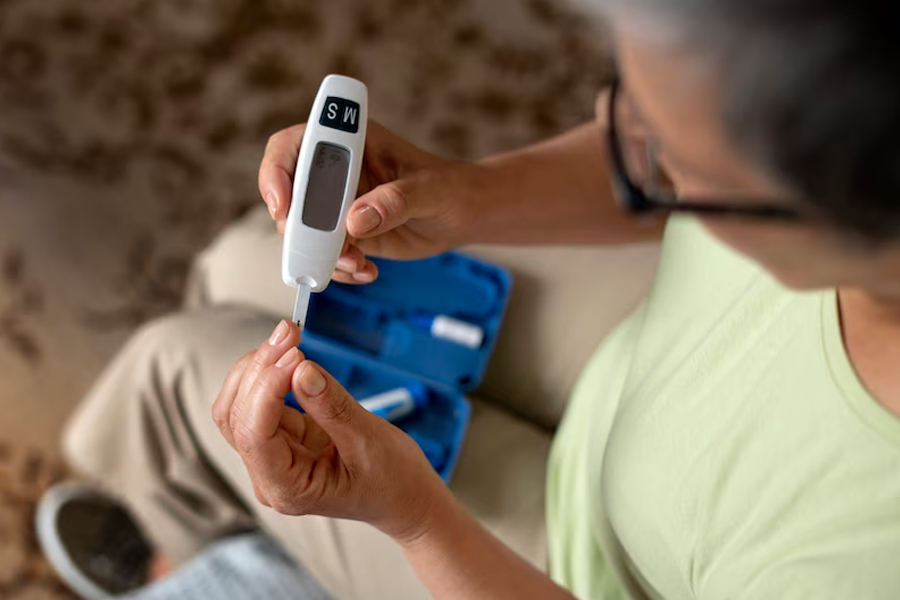
A diabetic coma is a serious and potentially life-threatening complication that can occur when blood sugar levels become dangerously high or low. This condition can strike suddenly, leaving individuals with diabetes vulnerable to severe health consequences, including unconsciousness and, in extreme cases, even death. Diabetic coma is one of the most critical emergencies associated with diabetes, highlighting the importance of strict blood sugar management and awareness of early symptoms. Recognising the signs of a diabetic coma and understanding its risk factors are essential steps in preventing this condition and ensuring a swift, effective response if it arises.
Table of Content:-
To understand this condition, OnlyMyHealth interacted with Dr Roohi Pirzada, MBBS, Consultant, Mumbai.
What is a Diabetic Coma?

Diabetic coma is a state of unconsciousness caused by prolonged, unmanaged diabetes. It can occur when blood sugar levels rise too high (hyperglycemia) or fall too low (hypoglycemia). As Dr Pirzada explains, "Diabetic coma is a life-threatening complication resulting from very high or very low blood sugar. Treatment depends on whether it is hyperglycemia or hypoglycemia."
A diabetic coma can lead to permanent brain damage or even death if not treated promptly. Immediate intervention can help patients recover, but recognizing early signs is critical to prevent escalation.
Symptoms of Diabetic Coma
Symptoms vary based on whether the coma is caused by hyperglycemia or hypoglycemia.
Symptoms of Hyperglycemia (High Blood Sugar): When blood sugar levels are too high, a series of symptoms may signal danger. Dr Pirzada outlines the common symptoms:
- Increased thirst and frequent urination – High glucose levels in the bloodstream cause the kidneys to work harder, leading to frequent urination and dehydration.
- Blurred vision – Excess sugar can pull fluid from eye tissues, impairing vision.
- Tiredness or weakness – High sugar levels can make the body feel sluggish and fatigued.
- Headache, nausea, and vomiting – These symptoms often accompany extreme hyperglycemia.
- Dyspnea (shortness of breath) – In severe cases, breathing may become laboured.
- Dry mouth and fruity-smelling breath – A distinct fruity odour in the breath may signal diabetic ketoacidosis, a dangerous condition associated with hyperglycemia.

Symptoms of Hypoglycemia (Low Blood Sugar): Low blood sugar can lead to symptoms like shakiness and anxiety. Dr Pirzada notes the following warning signs:
- Shakiness, sweating, and confusion – When blood sugar levels plummet, the body’s response may include sweating and trembling.
- Weakness and drowsiness – Low sugar levels can cause extreme tiredness and drowsiness, making it hard to stay alert.
- Loss of consciousness – In severe cases, the individual may faint or fall into a coma if blood sugar isn’t stabilised.
- Recognizing these symptoms promptly is essential, as they indicate blood sugar levels are either too high or too low.
Risk Factors of Diabetic Coma
Individuals with diabetes may have a higher risk of diabetic coma due to several factors. Dr Pirzada points out that "Risk factors include poorly managed diabetes, insulin delivery issues, and skipping meals or insulin." Other risk factors include:
- Illness, trauma, or surgery – These can disrupt blood sugar control, increasing the risk of hyperglycemia or hypoglycemia.
- Alcohol or substance abuse – Alcohol can lower blood sugar levels significantly and also interfere with diabetes medications.
- Hypoglycemia unawareness – Some individuals may not recognize the symptoms of low blood sugar, making them susceptible to a sudden drop.
Prevention of Diabetic Coma

To prevent diabetic coma, individuals should follow a proactive approach to manage their diabetes and blood sugar levels effectively:
Monitor Blood Sugar Regularly – Frequent blood sugar testing helps catch fluctuations early. Devices like continuous glucose monitors (CGMs) can be especially helpful for timely interventions.
Stick to Your Treatment Plan – Take prescribed medications on time, and avoid skipping doses of insulin or other diabetes medication. Adhering to a routine minimises the risk of dangerous blood sugar swings.
Balanced Diet and Regular Meals – Skipping meals can lead to sudden drops in blood sugar. Consuming balanced meals with a mix of proteins, carbs, and healthy fats helps maintain stable glucose levels.
Exercise Caution with Physical Activity – While exercise is beneficial, intense physical activities can cause blood sugar levels to drop. Monitoring blood sugar before and after exercise can prevent unexpected drops.
Stay Informed About Your Condition – Understanding symptoms, causes, and triggers of hyperglycemia and hypoglycemia can empower individuals to take timely actions.
By managing diabetes diligently and seeking prompt medical help when necessary, individuals can reduce the risk of diabetic coma and maintain a healthier, more stable life.
Also watch this video
How we keep this article up to date:
We work with experts and keep a close eye on the latest in health and wellness. Whenever there is a new research or helpful information, we update our articles with accurate and useful advice.
Current Version